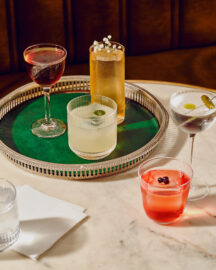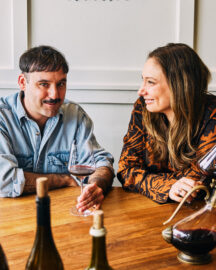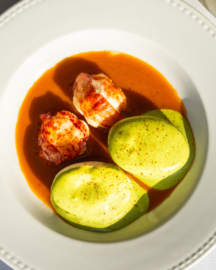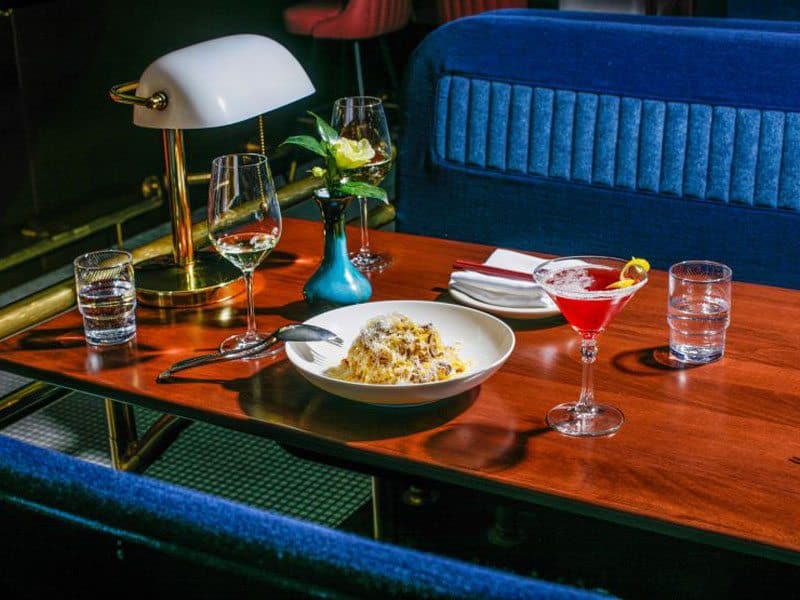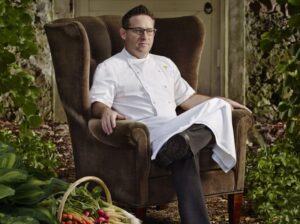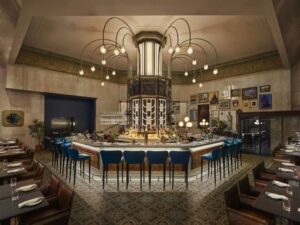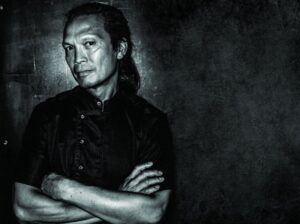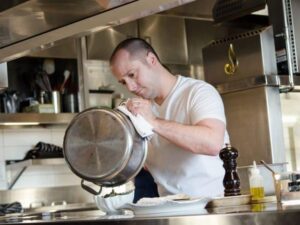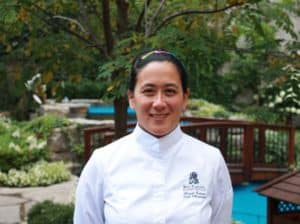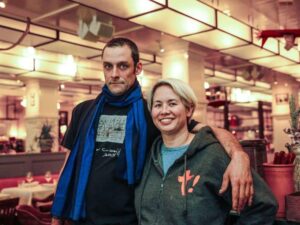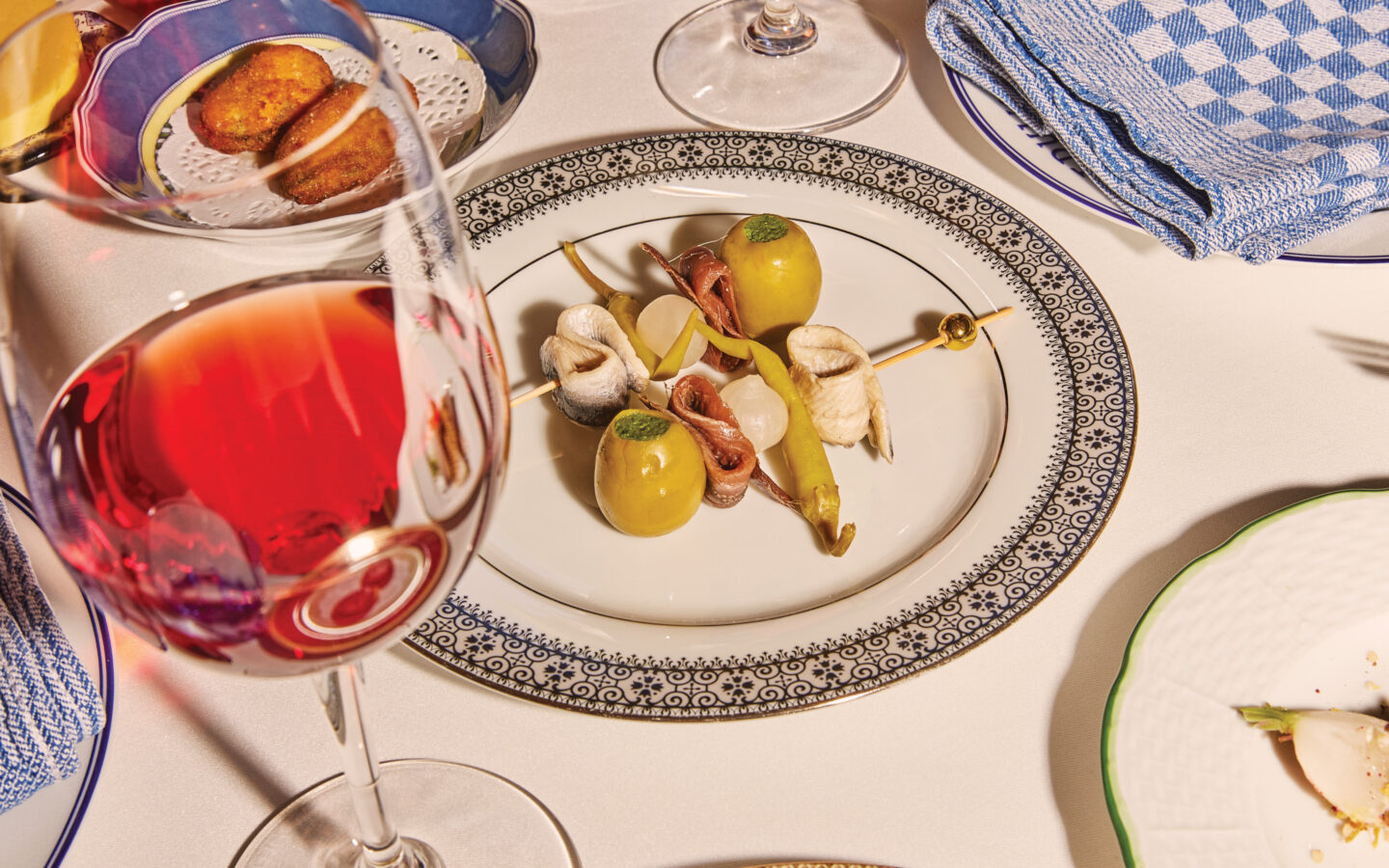Best New Restaurant 2017:
Kissa Tanto
IN A SHABBY SECTION OF VANCOUVER’S CHINATOWN, WHERE THE CONDO DEVELOPERS HAVE YET TO ENCROACH, A SNAZZY AWNING BECKONS FROM A FADED JADE-COLOURED BUILDING.
Presented by King Cole Ducks
All are welcome. Please come in.
…reads the gold lettering on the glass doorway. Inside the white-tiled entrance, another mysterious sign: “Please fix your hair and remove the mud from your boots.” Intrigued, we climb a tall staircase and step through parted curtains into Kissa Tanto, a sultry supper club from another time. It’s a place of glossy coved ceilings and gleaming brass bankers’ lamps casting a dim glow over peachy-rose bar stools. On the stereo, Japanese pop star Izumi Yukimura sings along to a swingy cha-cha-cha. Waitstaff in skinny black ties ferry beguiling plates of tobiko bruschetta and wakame tortellini through a stylish crowd that seems slightly—delightfully—stunned.
When Tannis Ling, owner of the lauded Chinese brasserie Bao Bei, announced that she would be opening a Japanese-Italian joint with her long-time executive chef Joël Watanabe and sous-chef Alain Chow, industry observers anticipated a sexy little nightspot with cool snacks. This was, after all, the same trio who had paired dumplings with craft cocktails and modernized the city’s Chinese dining scene in one shabby-chic swoop.
But no one, certainly not the three owners, ever imagined that this charmingly eccentric, genre-defying hideaway would soon become one of the most celebrated new restaurants in the country—and in our estimation, the best. Ling wanted a place that would be just as much a bar as a restaurant, somewhere “romantic and moody…where you could hold hands in dark corners.” Her inspiration sprang from Tokyo’s vanishing jazz cafés, jazu-kissa, which had their heyday in the 1960s.
The shagadelic bar, a long stretch of modernist Italian-styled millwork, brass trim and stacked vinyl records, has certainly turned out to be a seductive spot for losing track of time while sipping a frothy amaretto-and-plum-wine sour, or perhaps a Singapore Sling garnished with a wedge of charred pineapple. The tightly crafted cocktails are playfully retro, while the all-natural wine list follows more current trends. There is also sake, Japanese whisky, Italian aperitifs and local craft beer to lubricate the appetite.
In the early planning stages, food was almost an afterthought. When the interior design studio Ste. Marie demanded a more fully conceived concept, Watanabe says, he “threw out” Japanese-Italian and it stuck. Although there is a long-established history of red-sauce mishmashes (Itameshi) being popular in Japan, Watanabe’s graceful melding of the two cuisines is worlds apart from the frightful spaghetti Neapolitan (mixed with ketchup) that sustains Japanese students and salarymen. Italian-Japanese fusion, united by a common respect for seasonality and simplicity, has actually become quite sophisticated in Japan’s upscale restaurant scene.
It is no coincidence that Eataly opened one of its mega-markets in Tokyo in 2008, a full two years before New York got its first location. Led primarily by intuition and his own mixed heritage (his father is Japanese, his mother, Corsican-French Canadian), Watanabe’s whimsical meandering down the East-meets-West noodle trail has unearthed delicate sheets of handmade pasta layered with tender kasu-braised pork and smothered in miso besciamella. There is also porchetta-stuffed agnolotti gently swaddled in velvety smoked cream and hit with sour-salty punches of kombu-cured olives. Twisted knots of tortellini swim in a pool of elegantly clarified dashi broth strewn with chewy tendrils of purple seaweed.
For nibbling, there are fried olives stuffed with shiso and sausage, crusty house-made sourdough served with nori butter and olive oil, quivering chawan mushi egg custard spiked with Parmesan, bagna cauda amplified with bonito, and an inspired vegetable platter on ice that treats myriad pickles and fermented crudités with the reverence of a seafood tower. A more substantial meal might include a whole flash-fried fish lightly battered in potato flour and diamond-scored so that the opalescent flesh puffs into golden-crisped nuggets for finger-picking and dipping into grated-daikon soy sauce.
That so many unusual bedfellows come together with such natural ease is perhaps a testament to Watanabe’s long and winding career, a journey that has taken him from Ottawa (where he began working for the local-food-pioneering Domus Café, followed by several Japanese restaurants) to a lengthy stint in Montreal (including a stop at the venerable Il Mulino, with detours in Whistler (Araxi) and Australia (Scott Pickett’s The Point). That so many unusual bedfellows come together with such natural ease is perhaps a testament to Watanabe’s long and winding career, a journey that has taken him from Ottawa (where he began working for the local-food-pioneering Domus Café, followed by several Japanese restaurants) to a lengthy stint in Montreal (including a stop at the venerable Il Mulino, with detours in Whistler (Araxi) and Australia (Scott Pickett’s The Point).
Or maybe it has more to do with the magic of letting loose in the soulful places where imagination, much like jazz improvisation, can take you when accompanied by classic foundations, great ingredients and a passionate embrace. Lingering over the crumbled remains of an ethereally light tiramisu, the mascarpone whipped with tofu and the ladyfingers soaked in plum wine, we stare out the front windows.
A purple neon sign glows in the darkness at the edge of Chinatown. We could be anywhere—New York, Tokyo, San Francisco. But then we lock eyes with a wizened old man in a white undershirt, staring back at us from the rooming house across the street. We are right here, right now, in Vancouver at Kissa Tanto, the most captivating new restaurant in Canada, one that has us in its spell.
ARTICLE BY ALEXANDRA GILL
Share: Facebook, X (Formerly Twitter)

